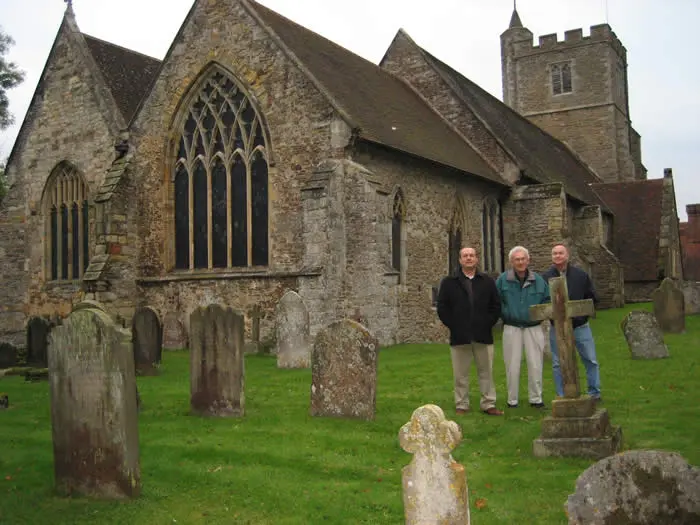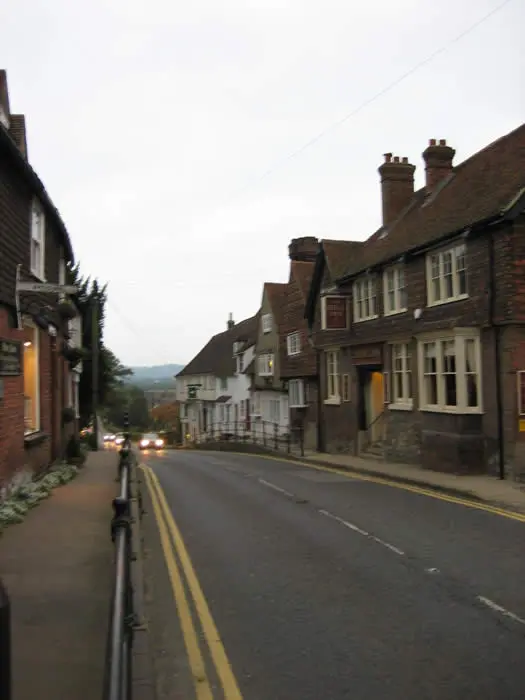Andrew Harris was born 1585 in Staplehurst, Kent and moved to Northbourne by 1603
Andrew Harris and his cousin Thomas Harris moved to the Deal, Kent area likely due to connections with other relatives and friends there. Little is known how Andrew met then married Jane Bagley in Northbourne in 1603. Andrew was a wheelright and he and Jane had 5 children. Several clues are derived by the associations and migration of Andrew's family after his death by 1616.
There is a link between many prominent passengers on the 1635 voyage of the Hercules, the dissident preacher John Lothrop and the children of Andrew Harris of Northbourne. For example, Parnell Harris and James Sayers, her step brother, sailed from Sandwich port (near Northbourne) in 1635. They would have known the leaders of this voyage prior to arranging their passage. These early pilgrims had long term connections before they boarded ships for such a risky and life-changing migration to early New England. Some passangers were from the local Sandwich area but mostly from the greater Tenterden area of Kent. Many were related or were associated by their common dissident beliefs. Many from the Hercules later joined at the new settlement in Scituate, MA. These associated early settlers of Scituate became known as “The Men of Kent”. John Lothrop who sailed from London in 1634 with many of his followers came to Scituate and was installed as the preacher. One of Lothrop's journals records Jane Harrice (likely the older sister of Thomas, William and Parnell) joined at Scituate, but no further records are found for her. Thomas and William Harris likely sailed from London (perhaps with Lothrop but did not join him in Scituate) but gathered with Roger Williams and settled Providence Plantation.

The parish church in Staplehurst
First on the list of passengers of the Hercules reveals Nathaniel Tilden, Yeoman from Tenterden, who was the most prominent of the group and part owner of the ship. He had previously traveled to the Scituate area to make arrangements for permanent residency for his family and associates. Listed second on the ship's record was Jonas Austin also of Tenterden. He (Austin), son of Jarvis and Mary (Bassock) Austin, was baptized at Staplehurst (about 8 miles North West of Tenterden) in 1598 and married Constance Robinson at Tenterden in 1627. Nathaniel Tilden was a close friend of Tilden, both families were well established in that region of Kent. He was a witness to a will in 1625 for William Robinson (Constance Robinson's first husband) and was witness to Willyam Austen will proved 20 June 1617.
In the Austin family genealogy, an important clue is found: Jonas Austen's aunt Joan/Joane/Johan Austin married Henry Harris in Staplehurst.
Records for this family are found in the Parish Registers and Transcripts of Staplehurst, Co. Kent, 1538-1630, beginning with their marriage (1)
“Henry Harris and Johan (Joane) Austin * “yonge ffolke” married 25 October 1579". (2)
"Young folk" likely means young and lacking money, household goods and probably a house. Elizabethans at age 12 had to be under a householder's guidance by law, therefore a 12-year-old living with his/her parents in the parental home would be called a servant. He/she would probably be apprenticed to someone else to learn a trade/housekeeping etc. Servants were not encouraged to marry. In the country many men waited to marry until their father died, and the family farm came to them. In Kent they had partible inheritance, called "gavelkind", so that the children of a family would automatically share all, unless father had made a will, in which case his written wishes prevailed, and he might very well keep the farm intact for one son. Usual age of marriage in the Tudor period was about 28 for men, 25 for women. However Staplehurst and surrounding weaving towns were boom-towns where it was stated that a child of 5 could earn his/her own living by carding or spinning wool etc., and earlier marriage was possible, especially if there was a child on the way.
No records are found for Henry Harris' birth about 1556 in the Staplehurst area.
Four children were born to Henry and Johan Harris.
John 14 Jul 1580 John s. Henry Harrys (3)
Sara 26 Apr 1584 Sarah d. Henry Harris (4)
An---- 6 Jun 1585 *An [blank] the [blank] of Henry Harris (Andrew) (5)
Dorytye 27 Apr 1589 Dorytye d. Henry Harris buried (6)
*Concerning this third child “An----”, on the original register of Christenings at Maidstone, clearly written, it states: 6 Jun 1585 An [then one and a half inch blank space] the [then one inch blank space] of Henry Harris.
Why was the information for this child incomplete? According to research, the original parish registers were often not written up on the day the event was made. Notes were kept and copied into the book later by the clerk and then the notes almost always thrown away. Perhaps the clerk could not read the note. Being unsure whether this was a daughter or son, he left it blank. The name Ann was often written An. But the blank must have meant there was more he was unsure of.
So it is the original register itself which has the blank in it, though this has been translated into various versions in the modern transcripts. The researcher did note that the name Andrew appears in other nearby parishes.
There is no entry of an Ann being married or buried in the Staplehurst parish to year 1642. What other name could have been represented by the An_____? besides Anthony, Andrew, Anne?
Johan Harris was buried 28 Oct 1586 with this note: “a pore woman wyf of Henry Harris”. Likely not poor financially, but poor health after the birth of Andrew? Perhaps her passing was so sad it prompted the notation of the scribe. She was not preceded in death by Henry.
The parish record does not show burials at Staplehurst of Henry. But it does show this burial which could conceivably be Henry's mother (or grandmother): 11 Jul 1556 Pernell w. Thomas Harrys (Henry was born about 1556, so Thomas and Pernell could have been his parents)
This rare name was given to Andrew Harris' second daughter Parnell, born 03 AUG 1606 Northbourne, Kent, England, perhaps after her grandmother.
One important connection between Staplehurst/Tenterden and Sandwich is found with the William Hatch family. William was originally from Tenterden area and was related by marriage to Nathaniel Tilden. Nathaniel’s wife Lydia Huckstep was a cousin of William Hatch. In preparation for his journey to the colonies, William Hatch moved his family to Sandwich sometime before 1634. There are various references with others from the Tenterden area that had dealings in the Sandwich area. William Hatch was a part owner of the ship Hercules.
Another heads of families from Sandwich of interest is Thomas Besbeech (Bisbee) whose mother was an Austin. He was on a later voyage from Sandwich to New England and joined family and friends at Scituate, MA.
When Andrew moved from Staplehurst to Northbourne prior to his marriage, we know not why or when, only that there were families and friends connected to both locations.
Andrew Harris married Jane Bagley on 2 Feb 1604 as recorded in the Northbourne Parish records. He would have been 18 at the time. Andrew was a wheelwright in Northbourne and may have been apprenticed there as a youth (around age 14).
Andrew named his second daughter Parnell possibly after his mother (or grandmother) Pernell. Andrew also named his second son after Thomas Harris his grandfather).
(1) The original Staplehurst registers are held at Canterbury including the Bishops' Transcripts. At Maidstone they have microfilm of the parish registers and also a different transcript from Canterbury.

(2) October 25 married Henry Harris & Joan Austen

(3) July 14 (1580) baptized John the son of Henry Harris

(4) 26 (April 1584) Sarah daughter of Henry Harris

(5) June 6 (1585) An __________ the _________ of Henry Harris

(6) Apr 27 (1589) Dorytye d. Henry Harris (buried)

Main street in Staplehurst, now a busy road in Kent
Thirty miles south of London and half way to the South coast of England lies an area of outstanding natural beauty combined with a fascinating history called the Weald. 120 miles long and 30 miles wide, the Weald of Kent, Surrey and Sussex encompasses the Lancaster Great Park formed in 1372 and renamed the Ashdown Forest in 1672.
A weald now refers to open countryside or to the special clays found in the Weald.
Despite heavy use of its timber for clay furnaces, the medieval cloth industry and by the shipbuilders the Weald remains one of the most heavily wooded areas of England. It is also one of the most important regions whence many English yeomen came to settle the new lands in New England.
Cloth making had been practiced in the area since Roman times, but the material produced was of poor quality, not very well woven, and required shrinking. Weavers were imported from Flanders, and found their raw materials were cheaper. These Flemish weavers settled in Tenterden, Biddenden, Cranbrook and Staplehurst, and brought with them the techniques of fine weaving, and of fulling to finish the cloth.
This high quality cloth was in great demand and brought wealth to those villages associated with the industry. Just take a look at the village of Biddenden and its row of weavers houses, to see some of the wealth created.
During the next 200+ years the cloth was created, and the majority exported into Europe, however this was due to stop in Queen Elizabeth I's reign.
Nestled in the Weald of Kent, Staplehurst lies within easy reach of London to the north west and Dover to the East.
From Cranbrook the cloth industry spread until it influenced most Wealden villages, including Staplehurst. The wealth thus generated was built into the solid timber houses of the Staplehurst clothiers and yeomen. In 1565, when a census of communicants was taken, the population was about 750. The woolen industry collapsed in the Weald about 1650, and though linen weaving and thread making took its place, such general prosperity never occurred again.
